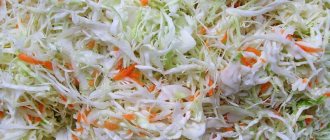Storage temperature
Sauerkraut is best stored at a temperature close to 0 degrees. Of course, temperatures up to 10 degrees Celsius are also suitable for short-term storage. But in this case, the fermentation processes will continue, and the cabbage will become acidic.
Therefore, the ideal temperature would be from 0 to +3 degrees Celsius . This temperature can be found in a refrigerator or cellar. A glazed loggia is also suitable if the mercury column there does not drop below zero.
Freezing
It should be noted right away that the process of freezing and subsequent thawing of sauerkraut destroys a significant part of vitamin C. Therefore, if freezing turns out to be an emergency measure, the product should be eaten immediately after it has thawed.
If this is not possible, for example due to the large volume, then re-freezing the product is strictly not recommended. If you decide to freeze cabbage, it is advisable to freeze it along with the released juice or brine. Or at least keep the brine in a bottle. Why? More on this a little later.
Capacity
If you are going to store sauerkraut for a long time, then you should pay attention to the container in which it is placed. Our ancestors often used oak tubs and barrels for these purposes. This is, of course, a way out.
But a pickled vegetable will significantly lose its unique taste if it sits in a barrel that smells of the dampness of a basement or the unpleasant amber of old wood. Therefore, when choosing a wooden container, make sure that it does not smell and will not spoil the taste of your preparations for the winter.
You should not store pickles in aluminum or steel containers. Oxidation processes will give the food a persistent metallic taste. This is not only not tasty, but also terribly harmful.
The best storage container would be an enamel or glass container. Stop your choice on it!
Can sauerkraut be kept warm?
Sometimes housewives have a desire to store sauerkraut in a warm room. For example, in a room or even in the kitchen. Is it possible to do this? You will be surprised, but yes! This is how you can do it. You just have to sprinkle the product with granulated sugar at certain intervals.
This need is due to the fact that granulated sugar, when exposed to an acidic environment, turns into vinegar. It, in turn, protects the cabbage from rotting.
If the pickle is over-acidified, you can also lightly sprinkle it with sugar before serving. Excess acidity will disappear, and all vitamin C will remain.
In addition, if possible, add cranberries or lingonberries to the container with sauerkraut. They remarkably help the workpiece to be preserved for as long as possible without losing its beneficial properties.
The only possible disadvantage of storing pickles in a warm place is the frequent appearance of mold. But this can be avoided.
Is it possible to freeze sauerkraut? Will it affect the taste?
It's easy and interesting to communicate here. Join us!
In Siberia everyone freezes cabbage, it’s normal.
And I freeze it too, it’s always crispy and tasty when defrosted.
After defrosting, cabbage will not lose its properties. You just need to freeze it once and thaw it too. If you repeat this several times, the cabbage will become tasteless.
I have lived my entire adult life (30) years and still live in the Far North (city of N. Urengoy). This is how cabbage was pickled back then (it was brought from Earth, but it was brought once a year). Defrosted pickled cabbage is a fairy tale when you put it on the table - it was a delicacy. It doesn’t lose its properties, it’s even crunchy. Well, if they write that it’s soft, then these people have never salted it correctly and in such volumes. The most important thing is not to keep it warm for a long time. when you take cabbage out of the cold. I have a daughter (and she is now over 30. She asks for just this kind of cabbage. Although I make salted cabbage just as well, namely the feeling of the smell of frost - that’s the highlight).
. If someone tells you that sauerkraut, after being stored in the cold, becomes “uncrispy and blobby”, “soft and tasteless”, “becomes useless” - rest assured, they do not know how to ferment cabbage. Even though I don’t live in the Far North (my respect to Olga Balabanova), our Siberia is also not the southern coast of the Adriatic. Believe me, no one here is choking on bloated and tasteless cabbage. And they are stored in the cold.
I think she will become nothing at all
You can freeze it, but you won’t like it after defrosting, it doesn’t lose its taste, but it becomes uncrispy and blobby
It definitely won't make her any better.
Can. It will just be soft when it thaws. This is how they used to do it - it froze in a barrel. I remember in the village I chopped it with an ax for dinner)))
It will become soft and tasteless.
everything will be OK. We've been doing this for 20 years, the taste hasn't changed.
In Siberia everyone freezes cabbage, it’s normal.
Basic Rules
Many housewives do not know how to store sauerkraut for a long time, so they usually cook it in small portions. But you can prepare this healthy vegetable in this form in large quantities. It is only important to know a few basic storage rules.
Under certain conditions, this dish will remain edible for a long time.
- First of all, housewives are interested in the question of storage location. The ideal option here would be a cellar. There the appropriate temperature and required humidity are maintained. In addition, the products in the cellar are protected from sunlight. But this option is not suitable for residents of apartment buildings, since they simply do not have a cellar. In this case, cabbage can be stored on the balcony or in the refrigerator.
- Before storing sauerkraut, it is poured with brine and pressed down with a press. Otherwise, the vitamin C in the product will quickly be destroyed. It is better to remove cabbage from the brine right before use.
- Many people think that it is necessary to store cabbage in glass, but in fact it can also be done in metal containers. It is only important that all necessary conditions are met.
- Although the cellar is the best place to store sauerkraut, mold can still grow in it, which can cause the product to spoil very quickly. But experienced housewives know that this unpleasant situation can be avoided, and they use several simple tricks. To prevent the development of mold, you can add cranberries to the cabbage. Some people periodically sprinkle the cabbage with sugar, mustard powder or grated horseradish. You can also put a cloth bag filled with mustard seeds.
Subtleties of storing sauerkraut
Sauerkraut is a way to preserve the vitamins that are present in fresh vegetables and even increase their amount due to the ingredients used and the preparation method.
To ensure that the storage period is long, and the product itself does not change its properties for the worse, it is recommended to follow certain storage rules, which vary depending on the specific method .
In banks
This type of dish is quite convenient to hold sauerkraut and at the same time, the jars do not take up much space on the shelves in the refrigerator. The key condition for obtaining a high-quality final product is mandatory and thorough washing of the container with hot water and subsequent sterilization.
It will eliminate pathogenic microorganisms, which often cause molding or souring of workpieces.
When the product is packaged in jars, it must be filled with brine so that the shredded cabbage is completely covered with liquid. After reaching the required level of brine, vegetable oil - sunflower or olive - is poured over it.
The jars are closed with plastic or sealed with metal lids and kept cool. The shelf life of blanks in this form is up to 1 month.
In barrels
Pickled or sauerkraut, which is aged in oak barrels, is characterized by high taste. It is left to be stored in these containers.
Plastic or wooden barrels are convenient , since there is no need to purchase a large number of other containers if you plan to ferment a lot of cabbage for the winter.
These preparations should be kept exclusively in a cool place ; most often they are sent to a cellar, basement or large refrigerator, where the thermometer readings do not rise above +2 ̊C.
Advice! So that the barrel can be used for fermentation for several years, a wooden tray must be placed under its bottom. When the bottom of the barrel comes into contact with a wet floor, it begins to rot, and in the case of plastic containers, it may become deformed for other reasons.
During barrel storage, when the container is regularly opened, a mold film will appear in the upper layer of brine and on the walls due to contact with air.
It must be removed in time and wiped with a natural cloth soaked in a concentrated saline solution.
This is interesting: Delicious summer preparations: cabbage with horseradish recipe for the winter
It is also necessary to regularly wipe and periodically keep (soaking duration - 10 minutes) in a concentrated saline solution the pressure circle that is in contact with the product.
In a refrigerator
A refrigerator is a suitable option for storing preparations , as it allows you to provide stable storage conditions for fermented products throughout the year.
The best packaging option for a refrigerator is rectangular plastic boxes or sealed bags, which allow for the most efficient use of the internal space of the chamber, which is impossible in the case of cans.
It is recommended to use several separate containers so that you do not have to put the entire volume of cabbage into a common container each time, which will reduce its shelf life. When the product is kept in sealed containers, the duration of its storage in the refrigerator is 30-45 days with the regulator in the middle position.
In the basement or cellar
The temperature and humidity in the basement or cellar during the winter season is optimal for storing sauerkraut . You can keep the workpiece in such conditions for quite a long time, especially when the cabbage is packaged in glass jars sealed with metal lids.
Important! In summer, it is impossible to keep cabbage in a cellar or basement for a long period of time without spoiling it, since even with good burial, the room temperature rises to +7 °C and higher, which reduces the storage duration to 1 month.
For storage, select a container that will extend the shelf life of the product for food. The main thing is that the metal utensils are inert and do not oxidize , and that there are no chips or other damage on the internal surfaces of the container.
Reference! Sauerkraut can be kept in enamel buckets and pans with tight-fitting lids.
In the freezer
When the temperature drops significantly, the concentration of vitamin C in sauerkraut decreases , but in some cases freezing is the only way to preserve the product suitable for consumption. You need to approach freezing cabbage thoughtfully, since a full container of frozen product is inconvenient to use, and you will have to defrost the entire volume.
Basic principles of freezer storage:
- Before freezing, the brine from sauerkraut should be poured into a separate container; excess water will spoil the cabbage itself.
- The drained liquid should also be saved - after defrosting, all the taste of the cabbage can be restored with brine.
- Cabbage should be packaged in equal portions in thick plastic bags - the quantity depends on the standard portion for single consumption.
After the product has already been packaged, the freezing process is simple - first lay the packages flat in the freezer. And when the cabbage is already frozen, put it in a stack into a container.
Before consuming a frozen vitamin product, transfer the required amount to the refrigerator 12 hours in advance. When the workpiece has already melted, shake it out into a bowl or jar, filling it with brine.
Storage temperature
Since it is recommended to store the product in places with cool temperatures, we can conclude that the temperature should be as low as possible, but not negative.
It is believed that the ideal temperature at which sauerkraut will be preserved for as long as possible is 2-5 °C.
Many housewives doubt whether it is permissible to leave sauerkraut on the balcony. It's all about what temperature is maintained there. If the balcony is glazed and insulated, most likely it will be too warm for sauerkraut, and the product will soon spoil. And if the temperature there coincides with the temperature outside, then in frosty weather such a storage place is also not suitable. After all, we cannot allow the product to freeze.
Sterilized sauerkraut
This recipe will allow you to store the product at home without a cellar or refrigerator for several months.
- shredded cabbage – 5 kg;
- salt – 85 g;
- sugar or honey – 75 g;
- bay leaf – 5 pcs.
Preparation
- Clean the head of cabbage from green leaves and cut out the stalk. Shred into thin strips. Add three tablespoons of salt and the same amount of sugar or honey, bay leaf, mix everything well.
- Place the cabbage in clean glass jars or an enamel pan, pressing tightly. A load is placed on top (a plate turned upside down and a jar of water). Keep until ready at room temperature for 3–5 days.
- Place the prepared sauerkraut in prepared, steamed glass jars with a capacity of one liter - three centimeters below the top of the neck. Cover the jars with prepared lids.
- Place the filled jars in a pan or bucket with water heated to 30 degrees and sterilize for 40 minutes. The water level in the pan should be three centimeters below the neck of the jar. The sterilization time begins to count from the moment the water boils in the pan. The boil should not be violent; the heat should be reduced so that the heating is minimal. Place a wooden grid or a rag at the bottom of the sterilization container.
- After sterilization, the jars are carefully removed from the water using special tongs or a towel. They roll up quickly.
Interesting: Storing Salted Mushrooms at Room Temperature
Prepare according to this recipe after harvesting in the autumn. Without peroxidation, without changing its taste, cabbage will last on the canned shelf until the summer. Perfect as a side dish for boiled potatoes, porridge, meat and fish dishes, for making vinaigrettes and cabbage soup.
Some housewives take the preparations out onto the balcony in the cool season. This is convenient to do if the balcony is well insulated and there is a closet there. In severe frost, the jars will still have to be brought into the apartment. If cabbage is stored in an enamel pan, it can be left on the balcony during frost. But when defrosting, such a product must be eaten as quickly as possible, which is not always possible.
Cold storage
The refrigerator maintains suitable conditions so that sauerkraut remains suitable for consumption for even several months. In this case, there is only one problem - volume. After all, we can put no more than 1-2 glass jars with this delicious delicacy in the refrigerator, which will be eaten much faster than it has time to spoil.
Knowing these simple rules and tricks for storing sauerkraut, you will be able to prepare much more of it than before. This will make your family's diet much healthier and more varied. After all, there is nothing tastier than this dish in combination with boiled potatoes or as a filling for a pie.
- First of all, housewives are interested in the question of storage location. The ideal option here would be a cellar. There the appropriate temperature and required humidity are maintained. In addition, the products in the cellar are protected from sunlight. But this option is not suitable for residents of apartment buildings, since they simply do not have a cellar. In this case, cabbage can be stored on the balcony or in the refrigerator.
- Before storing sauerkraut, it is poured with brine and pressed down with a press. Otherwise, the vitamin C in the product will quickly be destroyed. It is better to remove cabbage from the brine right before use.
- Many people think that it is necessary to store cabbage in glass, but in fact it can also be done in metal containers. It is only important that all necessary conditions are met.
- Although the cellar is the best place to store sauerkraut, mold can still grow in it, which can cause the product to spoil very quickly. But experienced housewives know that this unpleasant situation can be avoided, and they use several simple tricks. To prevent the development of mold, you can add cranberries to the cabbage. Some people periodically sprinkle the cabbage with sugar, mustard powder or grated horseradish. You can also put a cloth bag filled with mustard seeds.
What to do with frozen heads of cabbage?
Sometimes it happens that housewives do not have time to salt the heads of cabbage that are stacked on the veranda or balcony and are intended for further processing. If this cabbage freezes with the onset of cold weather, you should not immediately bring it into a warm room. It is better to defrost the heads of cabbage gradually in a cool place. When they thaw, it is possible that the cabbage will remain the same in texture or just a little softer than fresh.
Frozen cabbage will not be crispy enough after salting
It happens that only the top leaves of the head of cabbage are frozen. It is enough to remove them and use the rest for fermentation. But the head of cabbage can be completely frozen. It is necessary to remove damaged and rotten leaves, cut or drill out the stalk, after which this cabbage can be fermented. If the cabbage leaves are too flabby after defrosting, it is better to use them for current cooking rather than for pickling.
You can ferment cabbage that has been frozen in the same way as regular fresh cabbage:
- whole heads of cabbage;
- halves or quarters of heads of cabbage;
- shredded with or without various additives.
Frozen cabbage often ferments even faster than fresh cabbage. For 10 kg of vegetables take 200-250 g of salt. If the frozen cabbage juice released during the ripening process is not enough, you can add a little salted water.
Frozen cabbage may still be suitable for fermentation. Of course, this is possible if it has not become too flabby and the rotting processes have not affected the entire head of cabbage. As an independent dish, such sauerkraut will not be so good, but it will be suitable for preparing first and second courses.
Tags: make, freeze, cabbage, fresh
About the author: admin4ik
« Previous entry
Failures when sauerkraut: 6 mistakes that every second housewife makes
What is cabbage soup without sauerkraut? It seems that preparing the main ingredient of your favorite first course is as easy as shelling pears. However, when fermenting, housewives sometimes make mistakes that can significantly change the taste of cabbage and shorten its shelf life.
Knowing the main mistakes made when sauerkraut, you will never make them
Only properly fermented cabbage retains all its beneficial properties and vitamins until spring. To prepare it, it’s best to use good old white cabbage. Red cabbage varieties may have a slightly bitter taste after fermentation. In Galina Kizima’s “Great Encyclopedia of Gardeners and Gardeners from A to Z,” you will find useful recommendations for growing cabbage and tips for preparing it for the winter.
Cabbage frozen in the garden: what to do?
Many housewives often do not remove cabbage intended for pickling from the garden until the last minute. Late varieties are used for fermentation. They are cold-resistant and can withstand frosts down to -5 degrees well. The weather is often unpredictable, and you may find that the heads of cabbage freeze right on the vine.
There is no point in cutting them when they are frozen. It’s better to wait a little, because it’s possible that the next day the temperature will be above zero and the heads of cabbage will thaw. With short-term freezing on the root, usually nothing bad happens to them, and they are completely restored to their structure. And already thawed and dried cabbage can be cut, damaged leaves removed and used for further processing.
Advice. After removing cabbage from the garden that has already been frozen while standing, it is better not to delay processing the vegetable for a long time, but to ferment it immediately.
We invite you to familiarize yourself with: Pickled cabbage with beet chunks
The most common mistakes when sauerkraut
Kept at room temperature
For fermentation, three to four days at room temperature (+22...+24°C) are enough, and then the cabbage should be transferred to a cool or even cold place. This snack is especially good if stored in the cold. Take the right amount, defrost it - and enjoy its wonderful taste!
During fermentation, the resulting gases are not released
The cabbage layer must be pierced through its entire thickness with a knitting needle every day. Better yet, dump all the contents into a bowl, mix with your hands and put back into the container for further fermentation. It is enough to do this procedure once, 2-3 days after fermentation.
Didn't use oppression
Cabbage cannot be fermented without oppression (like mushrooms). The entire contents of the container must be completely immersed in brine.
Didn't add salt
Lack of salt can cause failure. For proper fermentation, you need to take one tablespoon of table salt (30 g) for each kilogram of cabbage .
Use iodized salt
You cannot use iodized salt (not only for sauerkraut, but also for all other preparations)!
Recipes - how to pickle or ferment frozen cabbage
If only the top leaves on the heads of cabbage are frozen, this will not affect the taste and beneficial properties in any way, but they are removed during preparation.
If the cabbage is completely frozen, the pickled vegetable will become soft, with a less pronounced taste, and the appearance of the pickled product will resemble porridge. If a vegetable has been frozen and thawed several times, almost all its beneficial properties will be lost.
There are many recipes for fermenting frozen heads of cabbage. We offer the most popular and easy to prepare.
When using any recipe, adhere to the general rules:
- Late varieties are planted/purchased for pickling;
- choose elastic heads of cabbage, without cracks, damage and signs of rot;
- do not use iodized salt - it will soften the vegetables even more;
- Do not ferment in aluminum containers - under the influence of acid, it releases substances harmful to the body.
Housewives sometimes wonder whether cabbage needs to be specially frozen before pickling. This procedure will not improve the taste of the finished product and will negatively affect its characteristics: the cabbage will not be crispy, slippery, or soft.
Simple Ambassador
For simple salting you will need 3 kg of cabbage, 90 g of carrots and 3 tbsp. l. salt.
Cooking method:
- Heads of cabbage are being chopped.
- Grate the carrots on a coarse grater.
- Mix vegetables and add salt.
- Mash the mixture with your hands until the juice comes out.
- After the juice has been released, the vegetables are placed in jars.
- Cover with gauze and leave in a warm place for three days. The workpiece is pierced twice a day to release gases.
- Transfer the finished product to the refrigerator or cellar.
With vegetables
For sourdough with vegetables you will need:
- 1 kg of white cabbage;
- 1 kg of cucumbers;
- 1 kg of sweet pepper;
- 1 kg of tomatoes;
- 2 kg carrots;
- 1 pod of hot pepper;
- 0.5 kg of green onions;
- 6 tbsp. l. salt.
We invite you to read: Making an original garden path from flagstone
Preparation:
- Shred cabbage.
- Grate the carrots on a coarse grater.
- Cut the cucumbers lengthwise into 4 parts, and the tomatoes in half.
- Remove the seeds from hot peppers.
- Everything is mixed, salted and placed in jars.
- Press down on top with a weight and leave for a week at room temperature.
- The finished cabbage is stored in a cool place.
Spiced
You will need: 4 kg of cabbage, 120 g of carrots, cumin (to taste), bay leaf (to taste), allspice (to taste), 100 g of table salt.
How to prepare:
- Shred the heads of cabbage and add grated carrots.
- Mash the mixture, stir and add salt.
- The bottom of the dish is covered with leaves and the vegetable mixture is laid out.
- Add spices and compact tightly.
- Pressed down with a load. Make sure that the brine always covers the cabbage.
- Place the container in a warm place for 6-7 days.
- The finished product is stored in a cellar or refrigerator.
With sugar
Take 3 kg of cabbage, 90 g of carrots, 3 tbsp. l. salt and 1 tsp. Sahara.
Preparation:
- Shred the cabbage and add grated carrots.
- Mix everything, add salt and sugar. Knead the mixture with your hands.
- Transfer the mixture into jars. Press down on top with a weight and place in a warm place for three days. The preparation will have a sweet and sour taste.










